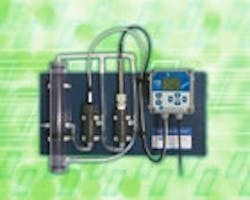New Chlorine Dioxide Analyzer Available
The CDA-22 from Electro-Chemical Devices is designed to measure chlorine dioxide in concentrations ranging from 0.05 to 20 ppm CIO2. It is ideal for application in municipal water systems, industrial cooling and rinse water, wastewater or other freshwater samples.
CIO2 exists as a gas in solution; it does not dissolve like other chlorine compounds and is therefore unaffected by the pH of the solution. CIO2 is approximately 10 times more soluble than chlorine in water, but it is volatile and can be easily removed from dilute aqueous solutions with minimal aeration, the company said.
The CDA-22 incorporates a CIO2 sensor, automated flow control device and analyzer/controller mounted on a PVC panel. Installation is complete after connecting the sample and drain lines, power and outputs. It can run for up to one year between electrolyte/membrane changes. Calibration of the CDA-22 is accomplished with DPD comparison.
The analyzer is built with a polarographic gold/silver PTFE membrane amperometric CIO2 sensor. The CDA-22’s output is virtually flow independent at values greater than 0.5 ft/sec, according to Electro-Chemical Devices. Its “constant head” flow control device maintains the sensor’s optimum flow over a wide range of incoming sample flow rates, from 10 to 80 gal/hr.
The sensor operates at a wide temperature range of 0 to 100ºC (32 to 212ºF). The chlorine flow cell includes a temperature sensor that allows the C22 analyzer to perform automatic temperature compensation of the measurement.
Source: Electro-Chemical Devices
